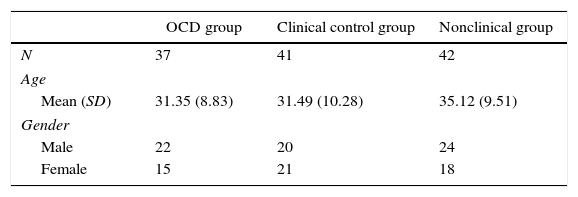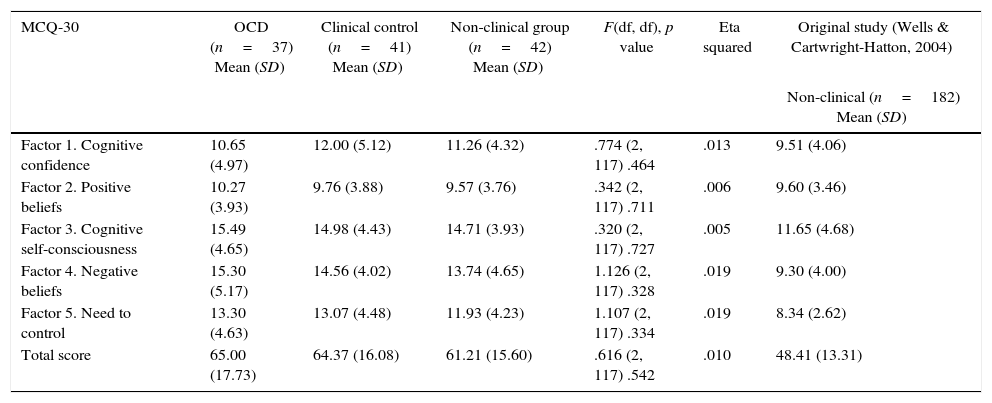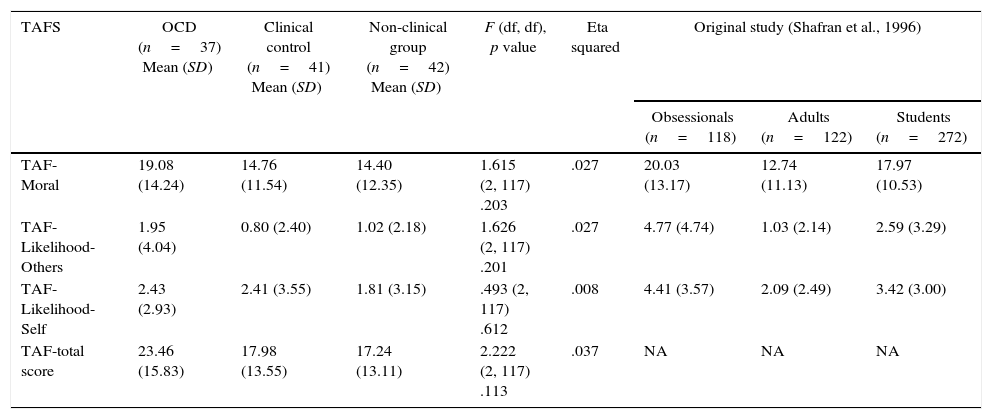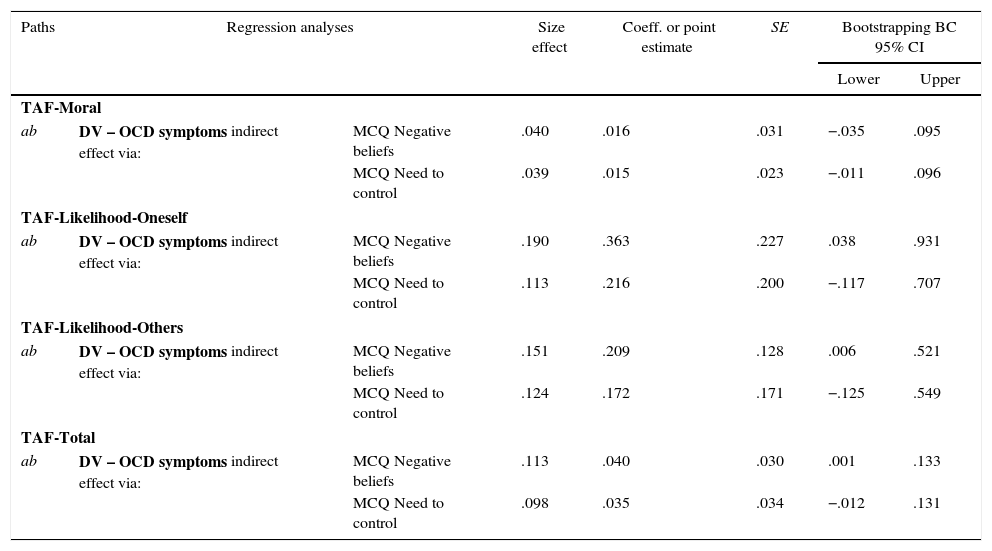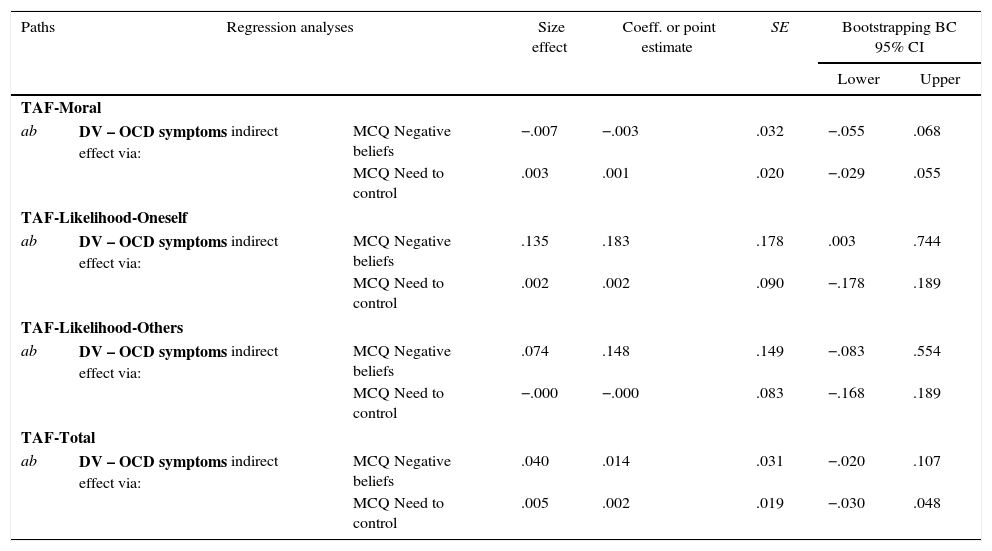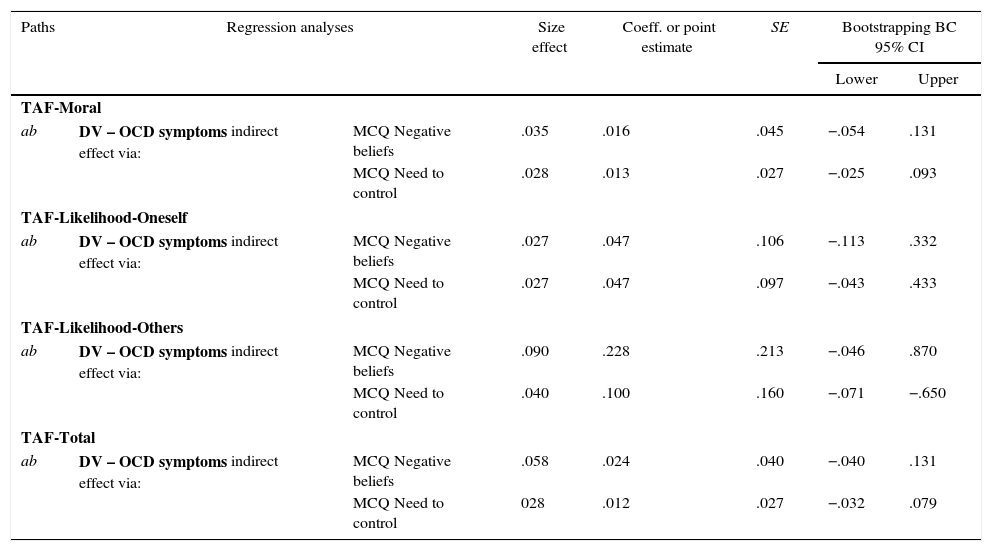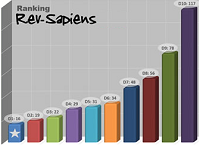Diverse studies support the central role of Thought-Action Fusion (TAF) and other metacognitive variables in the understanding of obsessive-compulsive disorder (OCD) symptomatology. However, a more detailed study of the involvement of these variables is needed. This article seeks to assess the possible mediating role of the factors of the Metacognitions Questionnaire (MCQ) in the relationship between TAF and OCD symptoms both in clinical and non-clinical samples. A cross-sectional design was used in which 120 participants, divided into three groups (two clinical and one non-clinical), completed the questionnaires assessing the constructs of interest. The mediational findings generally supported the proposed mediation model. Specifically, the mediational analyses focused on negative beliefs and the need to control (metacognitive factors of the MCQ) showed that MCQ Negative beliefs mediated the effects of TAF-Total and TAF factors (except for the TAF-Moral) on OCD symptomatology in the OCD group. The MCQ Need to control was non-significant as a mediator of the relationships between TAF and OCD. However, it was observed that this mediation approached significance, with considerable effect sizes. In the clinical-control group, the analyses showed that MCQ Negative beliefs mediated the effects of TAF-Likelihood-Oneself on OCD symptoms. In the remaining group, neither MCQ Negative beliefs nor MCQ Need to control were found to be significant mediators. It is generally concluded that certain beliefs, such as TAF, can evolve toward more complex metacognitive beliefs, which ultimately lead to the development of OCD symptoms.
Diversos estudios han señalado el papel de la fusión pensamiento-acción (TAF) y otras creencias metacognitivas en la comprensión de la sintomatología obsesivo-compulsiva. No obstante, es preciso un estudio más pormenorizado que esclarezca la contribución de estas variables. El objetivo del presente estudio es evaluar el posible papel mediador de los factores del Cuestionario de Metacogniciones (MCQ) en la relación entre la TAF y la sintomatología obsesivo-compulsiva, tanto en muestras clínicas como no clínicas. Con un diseño transversal, 120 participantes divididos en tres grupos (dos clínicos y uno no clínico) respondieron a los cuestionarios que evaluaban los constructos de interés. Los resultados apoyaron de manera general el modelo mediacional propuesto. Concretamente, los análisis se centraron en la necesidad de control y las creencias negativas (factores metacognitivos del MCQ) y mostraron los siguientes resultados. En el grupo de sintomatología obsesivo-compulsiva, las creencias negativas mediaron los efectos de TAF-total y los factores de TAF en la sintomatología obsesivo-compulsiva, a excepción de TAF-moral. El factor necesidad de control no llegó a ser un mediador significativo; no obstante, esta mediación estaba próxima a la significatividad y se contemplaron tamaños del efecto considerables. Respecto al grupo de control clínico, los análisis mostraron que las creencias negativas mediaban los efectos de TAF-probabilidad-uno mismo en la sintomatología obsesivo-compulsiva. En el grupo restante, ni las creencias negativas ni la necesidad de control resultaron ser mediadores significativos. Se concluye, de manera general, que creencias como la TAF pueden evolucionar hacia creencias metacognitivas más complejas que conllevan, en último término, el desarrollo de la sintomatología obsesivo-compulsiva.
Obsessive-compulsive disorder (OCD) is characterized by a series of recurrent and persistent thoughts, urges, or images denominated obsessions – experienced as intrusive and unwanted – as well as a series of behaviors called compulsions, performed in order to eliminate the distress provoked by the former (American Psychiatric Association, 2013). Most traditional psychological approaches to this symptomatology indicate the role of cognitive variables as a central element (Rachman, 1997). However, in recent decades, new cognitive approaches have emerged, attracting attention to metacognitions concerning the dysfunctional beliefs, in contrast to traditional cognitive models which focused on cognitive variables. Metacognitions refer to the structures and processes involved in the control, modification, and interpretation of one's thoughts. One of the most influential of these new approaches is the model of Self-Regulatory Executive Function (S-REF; Wells & Matthews, 1996). According to the S-REF model, a particularly problematic mode of processing associated with and directed by underlying metacognitive beliefs is conceptualized as one of major factors involved in the vulnerability to and maintenance of emotional disorders (Wells, 2009). Thus, metacognitive beliefs lead to the activation of a specific pattern of thinking called the Cognitive Attentional Syndrome (CAS). This consists of repetitive thinking in the form of worry and rumination, excessive attentional focus on thoughts and feelings, and coping behaviors such as avoidance and thought suppression. Specifically, Gwilliam, Wells, and Cartwright-Hatton (2004) suggest the existence of two broad types of metacognitive beliefs in OCD symptomatology: beliefs concerning the meaning and power of intrusive thoughts, and beliefs about the need to control thoughts and/or to perform rituals. The first set of beliefs have been termed “fusion beliefs” and include three types of fusion (Wells, 2009): Thought-Action Fusion (TAF), the belief that a thought alone can cause an unwanted action or have moral consequences; Thought-Event Fusion (TEF), the belief that a thought can either cause an event or else it means that an event has happened in the past; and Thought-Object Fusion (TOF), the belief that thoughts and feelings can be transferred onto objects. The second domain includes beliefs concerning the need to perform rituals to attenuate the consequences associated with obsessive thoughts. Most of the beliefs identified by the Obsessive Compulsive Cognitions Working Group – OCCWG as being essential to OCD can also be considered as metacognitive beliefs. In particular, regarding the beliefs evaluated with the Obsessive Beliefs Questionnaire (OBQ) designed for this purpose (OCCWG, 2005), the importance given to intrusive thoughts and need to control them as well as the need for certainty and responsibility for harm and overestimation of danger can be considered as metacognitive beliefs.
Several studies support the relation between metacognitions and OCD symptoms, thereby finding important correlations both in clinical and nonclinical samples (Grøtte et al., 2015; Myers & Wells, 2013; Rees & Anderson, 2013). Myers, Fisher, and Wells (2009) found that metacognitive beliefs are the main predictor of OCD symptomatology versus other related factors typical of traditional cognitive trends, such as responsibility or worry. Nevertheless, metacognitions also seem to play a relevant role in such diverse psychopathologies as depression (Halvorsen et al., 2015), eating disorders (Olstad, Solem, Hjemdal, & Hagen, 2015) or psychotic symptoms (García-Montes et al., 2013).
Most of the previous studies have assessed metacognitive beliefs with the Metacognitions Questionnaire (MCQ; Cartwright-Hatton & Wells, 1997), or with a shortened 30-item version, the MCQ-30 (Wells & Cartwright-Hatton, 2004). Exploratory factor analysis has supported a five-factor model consistent with the original MCQ: positive beliefs, uncontrollability and danger (negative beliefs), cognitive confidence, need to control thoughts, and cognitive self-consciousness. The factor related to negative beliefs about uncontrollability of thoughts and the factor referring to the need to control thoughts have been especially and significantly related to OCD (Bortolon et al., 2014; Cucchi et al., 2012), in the lines of the underlined text from OCCWG (2005) regarding the variable need to control thoughts as an essential belief of this symptomatology. Likewise, the cognitive confidence factor, which assesses the lack of confidence in cognitive functioning, has been pointed out as being closely related to this symptomatology (Cucchi et al., 2012).
Another construct specifically related to OCD since its origins is TAF (Shafran, Thordarson, & Rachman, 1996). TAF refers to a set of cognitive biases that lead to establishing incorrect causal relationships between thoughts and external reality. Factor analysis has revealed two forms of this phenomenon (Rassin, Merckelbach, Muris, & Schmidt, 2001). On the one hand, TAF-Moral, the belief that having an unacceptable thought is morally equivalent to performing it (i.e., thinking about blaspheming is as bad as actually blaspheming). And, on the other hand, TAF-Likelihood, the belief that having a thought about an unacceptable event increases the probability that the event will actually happen (i.e., thinking about injuring oneself after falling increases the risk of actually falling and being injured). Two subtypes of the TAF-Likelihood have also been distinguished: TAF-Likelihood-Oneself, the belief that a given event will happen to oneself, and TAF-Likelihood-Others, the belief that a given event will happen to others. As noted, the TAF construct was subsequently integrated into the metacognitive variables of OCD (Gwilliam et al., 2004). However, it has also been assumed that TAF could play an important role in other mental disorders such as major depression (Kivi & Ne’mat Mohammadipour Rik, 2013) or schizophrenia (Elif, Basaran, Hilal, & Ali Emre, 2008).
Before the growing development of the TAF construct, researchers had considered it as magical thinking (Shafran et al., 1996). This kind of thinking, according to García-Montes, Pérez-Álvarez, Odriozola-González, Vallina-Fernández, and Perona-Garcelán (2014), seems to occur particularly in children (Piaget, 1929) and so-called “primitive societies” (Golden, 1977). These beliefs are assumed to play a minimal role in adult behavior, only emerging prominently in stressful situations (Jahoda, 1969) or in psychological disorders, such as OCD and schizophrenia (Einstein & Menzies, 2008; García-Montes et al., 2013).
Therefore, it seems that TAF, or its predecessor, magical thinking, like other metacognitive beliefs, are related constructs and possibly central factors in the comprehension of OCD symptomatology. However, the predictor role of these constructs in OCD symptomatology and the relation between them is still unclear, and more detailed study of the involvement of these variables is needed. Elucidating these issues might not only lead to better understanding of the development and maintenance of OCD symptomatology but also to knowing how to implement more effective preventive and/or therapeutic strategies. Therefore, in this study, we aimed to investigate the role of TAF and other metacognitions evaluated by the MCQ in OCD symptoms both in clinical and nonclinical samples. For this purpose, we selected a clinically heterogeneous control group and a nonclinical control group. This selection is relevant to determine whether the role of these variables is specific to OCD symptomatology, or it can be observed in different symptomatologies, playing a similar role to that of other transdiagnostic variables involved in different problems, such as experiential avoidance (Hayes, Wilson, Gifford, Follette, & Strosahl, 1996). In this sense, firstly, we hypothesized that the group with OCD symptomatology and the clinical-control group would present a greater degree of TAF and other metacognitive beliefs than the nonclinical group. Secondly, we predicted that metacognition evaluated by the MCQ would be the best predictor of OCD symptomatology and, thirdly, that certain types of metacognition (need to control and negative beliefs) would mediate the relationship between TAF and OCD symptoms. These specific metacognitive variables were chosen due to their outstanding special relationship with OCD (Bortolon et al., 2014; Cucchi et al., 2012). These mediational results are compatible with the hypothesis that the metacognitive beliefs assessed with the MCQ are more complex cognitive factors, developed subsequent to previous cognitive factors such as TAF or magical thinking and, in turn, their development could ultimately lead to the performance of dysfunctional strategies that promote and maintain OCD symptomatology.
MethodParticipantsFor this study, we formed three groups of patients diagnosed with various disorders according to Diagnostic and statistical manual of mental disorders – fourth edition revised (APA, 2000) criteria.
Group 1 (OCD, n=37), patients diagnosed with OCD, mostly suffering from consciousness/doubt obsessions, followed by those related to checking. We were especially careful to rule out potential participants who presented with any other comorbid disorder; however, the group reflects the characteristic heterogeneity of OCDs. Group 2 (clinical-control group, n=41), patients treated by mental health services for diverse problems excluding OCD (adjustment disorder, n=7; generalized anxiety, n=6; anxiety disorder with agoraphobia, n=3; anxiety disorder without agoraphobia, n=1; posttraumatic stress disorder, n=1; severe stress disorder, n=1; personality disorder, n=4; major depressive disorder, n=5; dysthymia, n=3; unspecified depressive disorder, n=1; anorexia nervosa, n=1; bulimia nervosa, n=1; alcohol dependence, n=1; substance abuse, n=1; social phobia, n=1, specific phobia, n=1; marital problems, n=2; primary insomnia, n=1). We excluded patients who had previously been diagnosed with OCD. Group 3 (nonclinical group, n=42), people who attended a psycho-technical assessment center to renew their driving license. Participants who were receiving psychoactive medication or psychological treatment were excluded from the study.
Patients with OCD and those in the clinical-control group were receiving attention as outpatients from various psychologists. None of them was being treated with antipsychotic medication although, in some cases, they were receiving benzodiazepines or antidepressants.
Table 1 shows a summary of participants’ characteristics by group.
InstrumentsMetacognitions Questionnaire-30 (MCQ-30; Wells & Cartwright-Hatton, 2004). The MCQ-30 is a 30-item questionnaire rated on a 4-point Likert-type scale ranging from 1 (strongly disagree) to 4 (strongly agree). Factorial analysis carried out by the authors yielded five empirically differentiated and relatively stable factors: cognitive confidence, positive beliefs, cognitive self-consciousness, uncontrollability and danger (negative beliefs), and need to control thoughts. The MCQ-30 has shown good internal consistency, convergent validity, and acceptable test-retest reliability. We used the Spanish version employed by García-Montes et al. (2013), which showed good internal consistency for the global questionnaire (.91) and for the five subscales administered in this study (alphas from .77 to .85).
Thought-Action Fusion Scale (TAFS; Shafran et al., 1996). The TAF is a 19-item instrument rated on 5-point Likert-type scale that assesses psychological fusion of thoughts and actions in the following three subscales: TAF-Moral (e.g., “Having blasphemous thought is almost as sinful to me as a blasphemous action”); TAF-Likelihood-Others (e.g., “If I think of a relative/friend losing their job, this increases the risk that they will lose their job”); and TAF-Likelihood-Oneself (e.g., “If I think of myself falling ill, this increases the risk that I will fall ill”). This instrument was translated into Spanish according to recommendations of Muñiz, Elosua, and Hambleton (2013). Thus, we selected two translators, one familiar with the Spanish culture and another with that of the USA, and used the back-translation method; that is, the first translator translated into Spanish, and this translation was then translated back into English by the second translator. In this study, the alpha for the global scale was .89, and for the three subscales: .92 for TAF-Moral, .92 for TAF-Likelihood-Others, and .94 for TAF-Likelihood-Self.
Maudsley Obsessive-Compulsive Inventory (MOCI; Hodgson & Rachman, 1977). This classic questionnaire is widely used to measure OCD symptomatology. It has 30 items with a dichotomous true/false response format and contains four subscales: Cleaning, Checking, Slowness, and Doubting. We used the Spanish adaptation by Ávila (1986), which had an alpha coefficient of .81.
ProcedureAfter obtaining the research ethics committee's approval, all patients were assessed with semi-structured interviews to verify whether at that time they met the DSM-IV-TR (APA, 2000) diagnostic criteria for their group. Prior to application, all participants had provided their informed consent, after which they completed the three questionnaires in the order described above. Participants were encouraged to ask questions about any of the items that raised doubts. The patient's usual psychologist conducted the interview and administered the tests. The participants were not paid or rewarded.
Data analysisOur aim was to examine the role of TAF and other metacognitive beliefs assessed by the MCQ-30 on OCD symptoms. First, we compared the mean scores in the variables of interest in the three groups (OCD, clinical-control group, and nonclinical group) by means of analyses or multivariate analyses of variance. Secondly, we carried out three multiple linear regression analyses (one for each group), in which we introduced participants’ scores on the MOCI as dependent variable, and scores on the MCQ and TAF factors as predictor variables. Finally, we examined the potential role of certain MCQ factors (need to control and negative beliefs) as mediator variables of the effects of TAF on OCD symptoms (MOCI scores). For the last objective, we conducted parallel multiple mediation analyses in each group, using the nonparametric bootstrapping procedure for estimating direct and indirect effects with the model described by Preacher and Hayes (2008). In the mediation analyses, scores on the MOCI served as dependent variable, scores on the MCQ factors were used as the proposed mediating variables, and TAF factors and TAF-Total scores were the independent variables. Mediation was deemed as significant if the 95% bias corrected (BC) bootstrap confidence intervals (CI) for the indirect effects based on 20,000 bootstrapped samples did not include zero (see Preacher & Hayes, 2008). The effect sizes of MCQ scores as mediators of the effects of TAF factors or TAF-Total scores on OCD symptoms were computed using the completely standardized indirect effect (abcs; Preacher & Kelley, 2011) and providing 95% BC bootstrap CIs. This effect size can be interpreted as the expected change in the dependent variable (i.e., MOCI scores) per unit change in the predicting variable (i.e., TAF) that occurs indirectly through the mediator (i.e., MCQ Need to control). Following Kenny and Judd's (2014) suggestion, small, medium, and large effect sizes would be, respectively, .01, .09, and .25.
ResultsComparison statistics in relation to the participantsNo statistically significant group differences were found for participant's age, F(2, 117)=2.03, p=.136, nor was there any statistically significant difference in the patients’ distribution in the groups according to gender, χ2=1.01, df=2, p=.60.
Tests prior to analysis of the resultsWe verified the homogeneity of the error variances by means of the Levene test, finding that the data fulfill the assumption of homoscedasticity for the target factors of the MCQ: cognitive confidence, F(2, 117)=.64, p=.53; positive beliefs, F(2, 117)=.09, p=.92; cognitive self-consciousness, F(2, 117)=.35, p=.70; negative beliefs, F(2, 117)=1.30, p=.28; and need to control thoughts, F(2, 117)=.04, p=.96. Likewise, the MCQ-Total scores met the homoscedasticity assumption, F(2, 117)=1.27, p=.28.
The TAF-Moral subscale, TAF-Likelihood-Oneself, and TAF-Total scores satisfied the null hypothesis of the Levene test, respectively: F(2, 117)=1.45, p=.24; F(2, 117)=.71, p=.49; and F(2, 117)=.75, p=.48. However, the TAF-Likelihood-Others subscale violated this assumption, F(2, 117)=5.18, p=.007. Therefore, in this case, data were analyzed using Welch's test.
Lastly, participants’ MOCI-Total scores regarding the homogeneity assumption revealed no significant differences, F(2, 117)=.81, p=.45.
Comparison between groups in metacognitive variables, TAF, and OCD symptomsTo analyze possible statistically significant group differences in the metacognitive variables, we carried out a MANOVA, in which the participant's group was a fixed factor, and scores in the different MCQ factors or in the MCQ-Total were dependent variables. Wilks’ Lambda coefficient showed a nonsignificant global effect, F(10, 226)=.75, p=.68.
With regard to TAF, we carried out a MANOVA, in which the participant's group was a fixed factor, and scores on TAF-Moral and TAF-Likelihood-Oneself factors or TAF-Total scores were dependent variables. Wilks’ Lambda coefficient showed a nonsignificant global effect, F(6, 230)=1.31, p=.26. Regarding TAF-Likelihood-Others, Welch's test did not yield any significant group differences, T(2, 71.98)=1.12, p=.33.
Tables 2 and 3 show, respectively, a comparison of mean scores between this study and those reported in the original validation studies of the MCQ-30 (Wells & Cartwright-Hatton, 2004) and the TAFS (Shafran et al., 1996).
MCQ-30 scores of clinical and nonclinical groups compared with the nonclinical sample from the original study.
| MCQ-30 | OCD (n=37) Mean (SD) | Clinical control (n=41) Mean (SD) | Non-clinical group (n=42) Mean (SD) | F(df, df), p value | Eta squared | Original study (Wells & Cartwright-Hatton, 2004) |
|---|---|---|---|---|---|---|
| Non-clinical (n=182) Mean (SD) | ||||||
| Factor 1. Cognitive confidence | 10.65 (4.97) | 12.00 (5.12) | 11.26 (4.32) | .774 (2, 117) .464 | .013 | 9.51 (4.06) |
| Factor 2. Positive beliefs | 10.27 (3.93) | 9.76 (3.88) | 9.57 (3.76) | .342 (2, 117) .711 | .006 | 9.60 (3.46) |
| Factor 3. Cognitive self-consciousness | 15.49 (4.65) | 14.98 (4.43) | 14.71 (3.93) | .320 (2, 117) .727 | .005 | 11.65 (4.68) |
| Factor 4. Negative beliefs | 15.30 (5.17) | 14.56 (4.02) | 13.74 (4.65) | 1.126 (2, 117) .328 | .019 | 9.30 (4.00) |
| Factor 5. Need to control | 13.30 (4.63) | 13.07 (4.48) | 11.93 (4.23) | 1.107 (2, 117) .334 | .019 | 8.34 (2.62) |
| Total score | 65.00 (17.73) | 64.37 (16.08) | 61.21 (15.60) | .616 (2, 117) .542 | .010 | 48.41 (13.31) |
Note. MCQ-30: Metacognitions Questionnaire.
TAFS scores of clinical and nonclinical groups compared with samples from the original study.
| TAFS | OCD (n=37) Mean (SD) | Clinical control (n=41) Mean (SD) | Non-clinical group (n=42) Mean (SD) | F (df, df), p value | Eta squared | Original study (Shafran et al., 1996) | ||
|---|---|---|---|---|---|---|---|---|
| Obsessionals (n=118) | Adults (n=122) | Students (n=272) | ||||||
| TAF-Moral | 19.08 (14.24) | 14.76 (11.54) | 14.40 (12.35) | 1.615 (2, 117) .203 | .027 | 20.03 (13.17) | 12.74 (11.13) | 17.97 (10.53) |
| TAF-Likelihood-Others | 1.95 (4.04) | 0.80 (2.40) | 1.02 (2.18) | 1.626 (2, 117) .201 | .027 | 4.77 (4.74) | 1.03 (2.14) | 2.59 (3.29) |
| TAF-Likelihood-Self | 2.43 (2.93) | 2.41 (3.55) | 1.81 (3.15) | .493 (2, 117) .612 | .008 | 4.41 (3.57) | 2.09 (2.49) | 3.42 (3.00) |
| TAF-total score | 23.46 (15.83) | 17.98 (13.55) | 17.24 (13.11) | 2.222 (2, 117) .113 | .037 | NA | NA | NA |
Note. TAFS: Thought Action Fusion Scale. NA: data not available.
Lastly, in order to analyze possible statistically significant group differences in the MOCI scores, we carried out an ANOVA in which the participants’ group was a fixed factor and MOCI scores were the dependent variables. When a significant difference was found (p<.05), post hoc analysis using Bonferroni's correction was used to locate this difference. Table 4 shows the results of this analysis as well as that reported in the original validation of the MOCI (Hodgson & Rachman, 1977). The OCD group presented higher OCD symptoms than the clinical and nonclinical groups. However, there were no statistically significant differences between the OCD and the clinical-control group.
Mean scores and 95% confidence intervals.
| MOCI score | OCD | Clinical control | Nonclinical group | F(df, df), p value | Eta squared | Original study (Hodgson & Rachman, 1977) | |
|---|---|---|---|---|---|---|---|
| Obsessionals (n=100) | Neurotics (n=50) | ||||||
| Mean (SD) | 12.35a (5.61) | 10.17 (4.81) | 9.26a (5.50) | 3.46 (2, 117) .035 | .06 | 18.86 (4.92) | 9.27 (5.53) |
Note. Adjusted mean shown. Values sharing the same letter are significantly different, based on Bonferroni's correction.
To identify the MCQ and TAF factors that may predict predisposition to OCD symptoms as measured by the MOCI for each one of the groups in the study, we carried out three multiple linear regression analyses (see Table 5). Stepwise method was used to perform the regression. For this purpose, we introduced participant's scores in the MOCI as dependent variables and scores in the different MCQ and TAF factors as predictor variables.
Multiple regression analysis for MOCI (each group).
| Group | Scales | Partial correlation | β | T | p |
|---|---|---|---|---|---|
| OCD | MCQ Negative beliefs | .476 | .476 | 3.202 | .003 |
| Clinical control | MCQ Negative beliefs | .382 | .382 | 2.578 | .014 |
| Nonclinical | MCQ Negative beliefs | .572 | .533 | 4.354 | .000 |
| TAF-Moral | .396 | .330 | 2.694 | .010 |
Note. Method: Stepwise.
Statistically significant values were obtained for all groups, OCD group: F(1, 35)=10.250, p=.003; adjusted R2=.204; clinical-control group: F(1, 39)=6.644, p=.014; adjusted R2=.124; and nonclinical group: F(2, 39)=14.075, p<.001; adjusted R2=.389. As seen in Table 5, the factor with the most weight to account for OCD symptoms was negative beliefs.
Mediation analysis of the Effect of TAF on OCD symptoms through metacognitionsTables 6–8 show the data concerning the parallel multiple mediation analyses conducted to analyze the mediator role of metacognitive variables (negative beliefs and need to control) as measured by the MCQ in the effect of TAF and each of its three factors on OCD symptoms.
Data for the parallel multiple mediation analyses of the effects on OCD-symptoms of Thought-Action Fusion (TAF-Moral, TAF-Likelihood-Oneself, TAF-Likelihood-Others, and TAF-Total scores) through metacognitive variables (MCQ factors) for OCD group.
| Paths | Regression analyses | Size effect | Coeff. or point estimate | SE | Bootstrapping BC 95% CI | ||
|---|---|---|---|---|---|---|---|
| Lower | Upper | ||||||
| TAF-Moral | |||||||
| ab | DV – OCD symptoms indirect effect via: | MCQ Negative beliefs | .040 | .016 | .031 | −.035 | .095 |
| MCQ Need to control | .039 | .015 | .023 | −.011 | .096 | ||
| TAF-Likelihood-Oneself | |||||||
| ab | DV – OCD symptoms indirect effect via: | MCQ Negative beliefs | .190 | .363 | .227 | .038 | .931 |
| MCQ Need to control | .113 | .216 | .200 | −.117 | .707 | ||
| TAF-Likelihood-Others | |||||||
| ab | DV – OCD symptoms indirect effect via: | MCQ Negative beliefs | .151 | .209 | .128 | .006 | .521 |
| MCQ Need to control | .124 | .172 | .171 | −.125 | .549 | ||
| TAF-Total | |||||||
| ab | DV – OCD symptoms indirect effect via: | MCQ Negative beliefs | .113 | .040 | .030 | .001 | .133 |
| MCQ Need to control | .098 | .035 | .034 | −.012 | .131 | ||
Note. Path ab=total indirect effect.
Data for the parallel multiple mediation analyses of the effects on OCD-symptoms of Thought-Action Fusion (TAF-Moral, TAF-Likelihood-Oneself, TAF-Likelihood-Others and TAF-Total scores) through metacognitive variables (MCQ factors) for clinical-control group.
| Paths | Regression analyses | Size effect | Coeff. or point estimate | SE | Bootstrapping BC 95% CI | ||
|---|---|---|---|---|---|---|---|
| Lower | Upper | ||||||
| TAF-Moral | |||||||
| ab | DV – OCD symptoms indirect effect via: | MCQ Negative beliefs | −.007 | −.003 | .032 | −.055 | .068 |
| MCQ Need to control | .003 | .001 | .020 | −.029 | .055 | ||
| TAF-Likelihood-Oneself | |||||||
| ab | DV – OCD symptoms indirect effect via: | MCQ Negative beliefs | .135 | .183 | .178 | .003 | .744 |
| MCQ Need to control | .002 | .002 | .090 | −.178 | .189 | ||
| TAF-Likelihood-Others | |||||||
| ab | DV – OCD symptoms indirect effect via: | MCQ Negative beliefs | .074 | .148 | .149 | −.083 | .554 |
| MCQ Need to control | −.000 | −.000 | .083 | −.168 | .189 | ||
| TAF-Total | |||||||
| ab | DV – OCD symptoms indirect effect via: | MCQ Negative beliefs | .040 | .014 | .031 | −.020 | .107 |
| MCQ Need to control | .005 | .002 | .019 | −.030 | .048 | ||
Note. Path ab=total indirect effect.
Data for the parallel multiple mediation analyses of the effects on OCD-symptoms of Thought-Action Fusion (TAF-Moral, TAF-Likelihood-Oneself, TAF-Likelihood-Others and TAF-Total scores) through metacognitive variables (MCQ factors) for nonclinical control group.
| Paths | Regression analyses | Size effect | Coeff. or point estimate | SE | Bootstrapping BC 95% CI | ||
|---|---|---|---|---|---|---|---|
| Lower | Upper | ||||||
| TAF-Moral | |||||||
| ab | DV – OCD symptoms indirect effect via: | MCQ Negative beliefs | .035 | .016 | .045 | −.054 | .131 |
| MCQ Need to control | .028 | .013 | .027 | −.025 | .093 | ||
| TAF-Likelihood-Oneself | |||||||
| ab | DV – OCD symptoms indirect effect via: | MCQ Negative beliefs | .027 | .047 | .106 | −.113 | .332 |
| MCQ Need to control | .027 | .047 | .097 | −.043 | .433 | ||
| TAF-Likelihood-Others | |||||||
| ab | DV – OCD symptoms indirect effect via: | MCQ Negative beliefs | .090 | .228 | .213 | −.046 | .870 |
| MCQ Need to control | .040 | .100 | .160 | −.071 | −.650 | ||
| TAF-Total | |||||||
| ab | DV – OCD symptoms indirect effect via: | MCQ Negative beliefs | .058 | .024 | .040 | −.040 | .131 |
| MCQ Need to control | 028 | .012 | .027 | −.032 | .079 | ||
Note. Path ab=total indirect effect.
In the OCD group (see Table 6), the indirect effects of TAF-Moral on OCD symptoms through MCQ Negative beliefs and MCQ Need to control were nonsignificant. The indirect effects of TAF-Likelihood-Oneself, TAF-Likelihood-Others, and TAF-Total on OCD symptoms through MCQ Need to control were also nonsignificant, with medium effect sizes.
On another hand, the indirect effects of TAF-Likelihood-Oneself, TAF-Likelihood-Others, and TAF-Total on OCD symptoms through MCQ Negative beliefs were significant, with medium effect sizes.
Clinical-control groupIn the clinical-control group (see Table 7), the indirect effects of TAF-Moral, TAF-Likelihood-Others, and TAF-Total on OCD symptoms through MCQ Negative beliefs were nonsignificant. However, the indirect effect of TAF-Likelihood-Oneself on OCD symptoms through MCQ Negative beliefs was significant, with a medium effect size. The indirect effects of TAF-Moral, TAF-Likelihood-Oneself, TAF-Likelihood-Others and TAF-Total on OCD symptoms through MCQ Need to control were also nonsignificant.
Nonclinical control groupIn the nonclinical control group (see Table 8), the indirect effects of TAF-Moral, TAF-Likelihood-Oneself, TAF-Likelihood-Others, and TAF-Total on OCD symptoms through MCQ Negative beliefs were nonsignificant, as were the indirect effects of TAF-Moral, TAF-Likelihood-Oneself, TAF-Likelihood-Others and TAF-Total through MCQ Need to control.
DiscussionThis study hypothesized that patients with OCD and the clinical-control group are characterized by a higher degree of TAF and other metacognitive beliefs than the nonclinical group. This hypothesis was not confirmed. As shown in the comparative tables (Tables 2 and 3), the metacognition scores are fairly high in all three groups compared with the original study. Regarding TAF, although no differential behavior of our participants can be observed in comparison with the groups of the original study, there does seem to be a slight increase in the nonclinical participants’ TAF-Moral factor. In this regard, the observation of almost no group differences in OCD symptoms (Table 4) leads to questioning whether the random composition of the participant group of this study may have been notably biased toward the obsessive pole. Future studies would help clarify whether such bias actually occurred.
Secondly, it was considered that metacognitive beliefs and the TAF could both predict a predisposition to OCD symptoms, understood as a continuous variable present to a greater or lesser extent in all the participants. In this sense, the metacognitive negative beliefs factor was observed to be the main predictor of OCD symptomatology. This variable was shown to be relevant in previous studies (Bortolon et al., 2014; Cucchi et al., 2012) and a factor that is consistent with the S-REF model of Wells and Matthews (1996) for the prediction of OCD symptoms.
Thirdly, in order to understand the functioning of variables related to OCD, this study examined the hypothesis that the effects of TAF on OCD symptoms would be mediated by metacognitive beliefs. This hypothesis was partially confirmed. Thus, the mediation analyses in the OCD group showed that MCQ Negative beliefs mediated the effects of TAF-Total and TAF factors (except for the TAF-Moral) on OCD symptoms. The mediation analyses in the clinical-control group also showed that MCQ Negative beliefs mediated the effects of TAF-Likelihood-Oneself on OCD symptoms. Although the MCQ Need to control was nonsignificant as a mediator of the relationship between TAF and OCD, this mediation approached significance in the OCD group and, in fact, it had considerable effect sizes (medium). In the remaining group, neither MCQ Negative beliefs nor MCQ Need to control were found to be significant mediators. In general, as expected, these mediational findings are compatible with the hypothesis that certain metacognitive beliefs emerge after the development of other cognitive factors such as TAF or magical thinking. These findings are also compatible with data showing that this kind of magical thinking appears at early ages and is observed both in children and in so-called “primitive societies” (Golden, 1977; Piaget, 1929). In fact, in support of these findings, Table 3 shows that, in the original study, the obsessive groups obtained higher scores in TAF than those corresponding to nonclinical adults–this is a salient finding. Thus, according to our hypothesis, TAF evolves toward more complex beliefs (e.g., negative beliefs about the uncontrollability and danger of thoughts), which ultimately lead to the performance of dysfunctional strategies, consequently deriving in OCD symptomatology (according to the S-REF model). The implications of the findings presented and discussed herein for the development of psychological interventions should be treated with caution. Nevertheless, it is reasonable to propose preventive strategies that could limit the development of certain metacognitive beliefs and, therefore, OCD symptomatology. In particular, strategies aimed at allowing patients with OCD symptomatology to reduce the importance of the power and danger of thoughts. This coincides with some therapeutic lines such as those proposed by the third-generation therapies that promote acceptance of private events (see reviews in Bluett, Homan, Morrison, Levin, & Twohig, 2014; Ruiz, 2012).
This study presents a major limitation in its cross-sectional design, which does not allow determining whether changes in the predictor variables (i.e., TAF) preceded changes in the criterion variable (i.e., OCD symptoms) because causal relationships among variables cannot be assumed without establishing temporal precedence. This study has some additional limitations. First, as all data in this study were obtained using self-report measures, relationships among variables might be artificially inflated. Second, the size of samples of the study should be taken into account when observing significant effects of the assessed variables. Third, the description of the OCD symptomatology group, due to the failure to include variables such as severity, duration, etc. limits the interpretation of the results of the study. Fourth, the heterogeneity of the participants’ treatment stage when completing the questionnaires can lead to a potential bias in the study results. Fifth, the choice of the clinical-control group with diverse symptomatology can limit the results because it does not capture the specific behavior of the variables in a more homogeneous group. Sixth, the results focused only on the mediation of two metacognitive variables, thereby ignoring the possible mediational role of other metacognitive variables.
A future study replicating and extending the present findings would support the S-REF model of OCD and the central role of certain metacognitive beliefs in its development and maintenance. From this perspective, these metacognitive beliefs activate the specific pattern of thinking (CAS) that leads to a series of unsuccessful strategies such as behavioral avoidance, thought suppression, worry, rumination, or excessive attention to thoughts and feelings. This is problematic as it extends negative thinking, leads to reduced attentional flexibility, and a failure to exercise appropriate control over negative experiences (Wells, 2009). A growing body of evidence supports the metacognitive model of anxiety disorders (Normann, van Emmerik, & Morina, 2014). Lastly – in line with the other third-generation treatments of anxiety disorders (see reviews in Bluett et al., 2014; Ruiz, 2012), this study supports the idea that promoting alternative ways of responding to these metacognitive beliefs could be the main goal of the psychological treatment of OCD symptoms.
FundingThis work was done in the framework of research project PSI2009-09453, funded by the Spanish Ministry of Science and Technology. The first author also wishes to acknowledge Grant UNOV-06-BECDOC-4.



